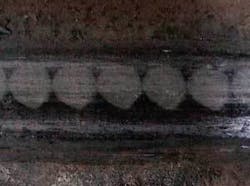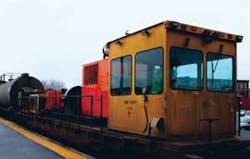Working on the railroad
Leaves adhering to train tracks, a serious and costly problem, are laser obliterated
Malcolm Higgins
A radio program in the summer of 1999 described a perennial autumn problem in the United Kingdom: ‘Leaves on the Line.’ Every autumn falling leaves become trapped and crushed between the wheels and rails of the railway system causing two problems: loss of traction and loss of electrical contact between the train and the rail (which adversely affects the signalling system). The crushed leaf residue becomes almost welded to the track, taking on the appearance of a Teflon-like coating, and is particularly difficult to remove. Incredibly, more than 3000 people a night throughout autumn were deployed to hand-scrub the rails to clean them. In addition, water jetting was used to clean rails and a sand-based product applied to help improve traction, but they were expensive and not particularly effective.
A modern solution was needed. With their wide use in industry lasers were an obvious place to look. So a goal became the development of a laser-based system mounted under perhaps 1 out of 10 passenger trains that worked automatically to keep the lines ‘swept’ clean. A Limited Company, LaserThor was set up to explore this idea.
LaserThor contracted for investigations to be carried out at the DERA Laboratories (Malvern, England) and the Rutherford Appleton Laboratories (Chiltern, England). They identified the Nd:YAG laser as being the most suitable. Key factors in that decision included: the wavelength emitted (1064 nm), the relative stability of the technology, the ability to Q-switch (concentrate the energy) and increase the power at the ablation point, and the emerging development of diode-pumped technology in the solid-state laser field. The laboratory work identified the need for high peak power at the ablation point in order to dislodge the leaf residue from the rail, and the Nd:YAG laser offered the potential for this. The principle limitation of the Nd:YAG laser was that compact (for train mounting) commercially available machines only produced 60W output, then the only diode-pumped units available in the U.K. that were being used for etching or marking. The alternative, flashlamp Nd:YAG lasers, were too large, inefficient, expensive, and dependent on expert operators to be of any practical use in a railway environment.
However, having approached Railtrack, the company responsible for the U.K. railway network, it was agreed to run a trial on a main line in the autumn of 2000 to assess the potential of the technology. A flashlamp pumped Nd:YAG laser was borrowed and fitted into a railway carriage, with the support equipment and external chiller mounted in another railway carriage. The laser beam was directed down a tube suspended vertically above one rail. The laser gave 100W output in CW mode and produced pulses of light at 10 Hz. Each pulse ablated a circular area of about 20mm diameter (see Figure 1).
The trials were successful in proving the concept of using lasers to ablate railhead contamination. Indeed, it was found that not only could leaf residue be removed but also a wide range of oils, greases, ice, water, and light rust were effectively ablated with a single pulse. However, there were also severe limitations with the type of laser that had been used as described above plus it only cleaned at 2 mph, had serious safety concerns because of the CW beam, and was too temperamental (being unable to cope with the vibrations and so on of the railway carriage) (see Figure 2).
Undaunted, discussions between Network Rail (formerly Railtrack) and LaserThor resulted in an outline specification as a target: the system would have to operate at 40 mph and clean a 20mm band within specified areas of each rail. It was immediately clear that the principle goal of mounting units under passenger trains was unattainable in the short term, so a maintenance version, to be mounted on a specialist track maintenance train, was set as the goal.
LaserThor’s first challenge was to develop a high-powered laser. Laboratory research commissioned by the company and conducted at Rutherford Appleton Laboratories had identified the need for a final system with perhaps 4 kW output but it was felt this would be too big a leap (from the then available 60W), so a less-ambitious target of developing a 1kW system was agreed. Enquiries led to a meeting at the Fraunhofer Institut für Lasertechnik (ILT), Aachen, Germany. A specification was agreed upon and in September 2001 a 1kW output Nd:YAG laser, which was diode pumped and Q-switched, operating at 25 kHz was delivered (see Figure 3).
The laser pulses were delivered via 600µm fiber, and the beam was focused via a series of static optics contained inside an optics box to produce a rectangular footprint onto the railhead. ILT had also developed the optics-a task that was a serious challenge in its own right as they were to be mounted very close to the railhead and would be subjected to significant G forces, vibrations, and shocks whenever the train was moving.
Before such a high-powered laser could be taken onto a train and used on main line, obvious safety issues had to be considered and resolved. The focused beam significantly reduced the optical hazard distances but it still needed to be enclosed and prevented from escaping while in a hazardous state. The integrity of the screening needed to be maintained and ensured at all times, so a series of interlock switches, position sensors, and monitoring devices had to be installed and tested. Potential damage to track and trackside equipment also needed to be assessed, requiring exhaustive testing and monitoring. EMC, both emission and inoculation, were evaluated and noise and environmental impact studies carried out. The railway people had to be satisfied that the system would be safe to operate on the main line-but so too did the people who would be standing trackside monitoring the laser’s performance.
The 1kW laser was mounted inside a purpose-built container and fitted to a maintenance train. Trials were conducted throughout the autumns of 2001 and 2002 as well as out-of-season laboratory testing. The combination of solid-state and diode technologies proved successful; giving a reliable and stable output from the moving, shuddering, and vibrating train. The culmination of the trials was a successful demonstration of the system ablating a 20mm strip of one rail at a speed of 20 mph-exactly as calculated and to the delight of all onlookers (see Figure 4).
The task then became one of scaling up the system to meet the railway specification. The laser technology was transferred from ILT to Rofin-Sinar GmbH (Hamburg, Germany), which modified one of its standard-design DY Nd:YAG lasers to accommodate two laser heads each giving a 1kW output. Two prototype systems were designed and built. Each system was based inside a custom 20ft container and 10ft support base and consisted of the following: two Rofin-Sinar modified DY lasers, laser control unit, air conditioning unit, and electrical control panels inside the container, and a secondary chiller and generator on the support base. The laser beams were delivered via four fibers (two to each rail) via optical boxes and through the screening boxes that were mounted under the train. The systems were controlled by a railway employee from a simple control panel in the cab of the train (see Figure 5).
Testing in real conditions on the main line throughout the autumns of 2003 and 2004, as well as out-of-season testing in those years and in 2005, was carried out by an internationally known and respected engineering consultancy, who concluded: “Lasers provide an opportunity to improve autumn performance. They are able to treat longer distances since they are not limited by the capacity of the water and Sandite tanks,” and “The laser system treating at 40 mph has been shown to remove contamination and improve adhesion.”
LaserThor, the company behind the development of the Laser Railhead Cleaner, is now actively seeking a partner to help take the prototype design through to production and actually marketing operational units worldwide. The goal of further developing the system for fitting under passenger trains remains but more compact high output lasers will be needed. And, although technology is moving in the right direction, there is still some way to go before we can achieve it.
Malcolm Higgins ([email protected]) is founder and director of LaserThor Ltd (www.laserthor.com).
Rail debris
Rail debris affects railroads by limiting adhesion for pulling tonnage or braking force for stopping and preventing continuous low-voltage electrical contact for signaling purposes. Train traction depends upon a very small point of contact where the wheel meets the rail. Ideally this interface would be clean steel meeting clean steel, at the same temperature, to provide the best adhesion. Any degradation affects not only the amount of tonnage that can be started and hauled, but also the effective stopping distance.
Leaf and other debris trapped by several tons of wheel pressure against the immoveable rails tends to create a smooth and slippery paste that can be smeared over a distance. The effect tapers off as this paste dries, and the residue will wear off after multiple wheel passes. This debris can also be spread on the wheels to reduce their effective contact with brake shoes. Wheels have a greater tendency to slide during brake applications while rolling over this slippery material.
In addition, signal systems-designed to prevent trains from running into each other-rely on the continuous contact of wheels to rails to provide occupancy detection. Signal systems are designed to prevent trains colliding and to protect the public. When debris prevents reliable contact, the signal systems can become degraded to the point of failure. This effect is particularly noticeable with passenger trains.
Traditionally, North American railroads have treated the first symptom by adapting locomotives to deposit a fine dusting of sand onto the rail surface ahead of the driving wheels to increase adhesion. This has a limited effect because, when the sand is crushed and broken down into powder, it increases wheel-to-rail friction, and then tends to attract moisture and other debris. Modern locomotives are equipped with automatic systems to determine if sand is needed and apply it at appropriate times. Detection systems monitoring the slippage that occurs under power and acceleration don’t know if a wheel is slipping while braking.
The second symptom affects passenger railroading more than freight due primarily to train lengths. While the initial effect is the same to both, freight trains tend to wear the debris off faster, with more wheels on longer trains. Passenger trains generally have fewer wheels to clear debris and thus are more susceptible to signal failures.
Passenger and transit systems generally have less territory to maintain than freight railroads. With less trackage, and the need to maintain regular published schedules meaning more crowded operations, passenger and transit operators have been at the forefront of North American attempts to clean rail.
The use of brush and/or washing systems has met with some success. One such system (shown) requires a work train, operating between normal passenger traffic. This system requires a large volume of filtered water (located in the tank car), projected at very high pressure (16,000 psi) through nozzles aligned across the rail head. These waterjets are strong enough to cut rail if they sit still long enough.
North American freight railroads, in general, have accepted the degraded performance debris can cause. Most of the current solutions are not efficient for the amount of territory and service required. A road vehicle with rail wheels based cleaning system would be most useful, allowing one or two workers to concentrate on the worst locations and move between trouble spots quickly. A cost-effective locomotive-mounted system that could sense debris and clean it right ahead of the driving wheels would be an ideal solution.
- Steven Belforti, Guilford Rail System






